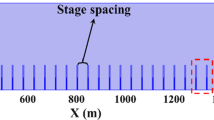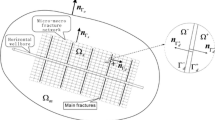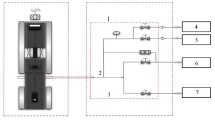Abstract
Micro-scale fractures exist in shale reservoirs and are always well developed. In shale gas formations, there always exist other gases which are transported together with methane through the micro-scale fractures. In this study, a novel multi-component shale gas transport model in micro-scale fractures is proposed. The new model takes the effect of fracture opening, multi-component gas, and pressure-viscosity relationship into consideration. New equations for Knudsen number and mass flow rates of slippage flow, Knudsen diffusion, and coupled flow are presented. Results showed that (a) the model can reasonably depict the gradual change of the contribution of each transmission mechanism of micro-fracture gas to transmission at different development stages; (b) the higher the ratio of fracture width to opening, the greater the gas transmission capacity, which is more obvious in the case of micro-fractures with high pressure and large opening; and (c) the CO2 fraction has a significant influence on the mass flow rate of slippage flow, continuum flow, Knudsen diffusion, and coupled flow, but it has a weak influence on the contribution fractions of these flow patterns. This model can be implemented in simulations for history-matching production data.







Similar content being viewed by others
References
Adzumi H. Studies on the flow of gaseous mixtures through capillaries. III. The flow of gaseous mixtures at medium pressures. Bull Chem Soc Jpn, 1937, 12 (6): 292–303
Azom, PN, Javadpour F. Dual-continuum modeling of shale and tight gas reservoirs. In: Proceeding of SPE Annual Technical Conference and Exhibition, San Antonio, Texas, USA, October 8–10, 2012. SPE 159584
Beskok A, Karniadakis GE (1999) A model for flows in channels, pipes, and ducts at micro and nano scales. Microscale Thermophy Eng 3(1):43–77
BinderK,HorbachJ,KobW,etal. Molecular dynamics simulations. J Phys: Condens Matter, 2004, 16: S429-S453
Brown GP, DiNardo A, Cheng GK et al (1946) The flow of gases in pipes at low pressures. J Appl Phys 17(10):802–813
Browne VA, John JEA (1970) Vacuum radial flow from the viscous through the free molecule regime. Vacuum 20(12):525–533
Chalmers GR, Bustin RM, Power IM (2012) Characterization of gas shale pore systems by porosimetry, pycnometry, surface area, and field emission scanning electron microscopy/transmission electron microscopy image analyses: examples from the Barnett, Woodford, Haynesville, Marcellus, and Doig units. AAPG Bull 96(6):1099–1119
Chen J, Xiao XM (2014) Evolution of nanoporosity in organic-rich shales during thermal maturation. Fuel 129:173–181
Coppens MO, Dammers AJ (2006) Effects of heterogeneity on diffusion in nanopores from inorganic materials to protein crystals and ion channels. Fluid Phase Equilib 246(1–2):308–316
Darabi H, Ettehad A, Javadpour F et al (2012) Gas flow in ultra-tight shale strata. J Fluid Mech 710:641–658
Eldridge BD, Brown LF (1976) The effect of cross sectional pore shape on knudsen diffusion in porous materials. AIChE J 22(5):942–944
Ertekin T, King G, Schwerer F (1986) Dynamic gas slippage: a unique dual-mechanism approach to the flow of gas in tight formations. SPE Form Eval 1(01):43–52
Feng D, Li X, Wang X, Li J, Zhang X (2018a) Capillary filling under nanoconfinement: the relationship between effective viscosity and water-wall interactions. Int J Heat Mass Transf 118:900–910
Feng D, Li X, Wang X et al (2018b) Water adsorption and its impact on the pore structure characteristics of shale clay. Appl Clay Sci 155:126–138
Feng D, Li XF, Wang XZ, Li J, Zhang T, Sun Z, He MX, Liu Q, Qin JZ, Han S (2018c) Capillary filling of confined water in nanopores: coupling the increased viscosity and slippage. Chem Eng Sci 186:228–239
Feng D, Li XF, Wang XZ, Li J, Zhang T, Sun Z, He MX, Liu Q, Qin JZ, Han S, Hu JC (2018d) Anomalous capillary rise under nanoconfinement: a view of molecular kinetic theory. Langmuir 34(26):7714–7725
Fengrui S, Yuedong Y, Guozhen Li, Wenyuan L (2019a) Simulation of real gas mixture transport through aqueous nanopores during the depressurization process considering stress sensitivity. J Petrol Sci Eng 178:829–837
Fengrui S, Yuedong Y, Guozhen Li, Xiangfang Li (2019b) A slip-flow model for multi-component shale gas transport in organic nanopores. Arab J Geosci 12(5):143
Fengrui S, Yuedong Y, Guozhen Li, Mingda D (2019c) Transport behaviors of real gas mixture through nanopores of shale reservoir. J Petrol Sci Eng 177:1134–1141
Gad-el-hak M (1999) The fluid mechanics of microdevices – the Freeman scholar lecture. Trans ASME: J Fluids Engng 121:5–33
Hanliang Fu, Mengmeng W, Peng Li, Jiang Song Hu, Wei GX, Ming C (2019) Tracing knowledge development trajectories of the internet of things domain: a main path analysis. IEEE Trans Industr Inf 15:6531–6540
Hanliang Fu, Manogaran Gunasekaran Wu, Kuang CM, Song J, Aimin Y (2020) Intelligent decision-making of online shopping behavior based on internet of things. Int J Inf Manage 50:515–525
Javadpour F (2009) Nanopores and apparent permeability of gas flow in mudrocks (shales and siltstone). J Can Petrol Technol 48(08):16–21
Javadpour F, Fisher D, Unsworth M (2007) Nanoscale gas flow in shale gas sediments. J Can Petrol Technol 46(10):55–61
Jian Z, Mingjian C, Yigang He (2020) Robustness and adaptability analysis for equivalent model of doubly fed induction generator wind farm using measured data. Appl Energy 261:114362
Karniadakis G, Beskok A, Aluru NR (2005) Microflows and nanoflows: fundamentals and simulation. Springer Verlag, New York
Keliu Wu, Xiangfang Li, Zhangxing C, Li Junjian Hu, Yuan JL (2015) Gas transport behavior through micro fractures of shale and tight gas reservoirs. Chinese Journal of Theoretical and Applied Mechanics 47(6):955–964
Tae Hong Kim, Jinhyung Cho, Kun Sang Lee. Evaluation of CO2 injection in shale gas reservoirs with multi-component transport and geomechanical effects. Applied Energy, Volume 190, 15 March 2017, Pages 1195–1206
Kulga B, Ertekin T (2018) Numerical representation of multi-component gas flow in stimulated shale reservoirs. J Natl Gas Sci Eng 56:579–592
Li J, Li X, Wu K et al (2017) Thickness and stability of water film confined inside nanoslits and nanocapillaries of shale and clay. Int J Coal Geol 179:253–268
Li J, Chen Z, Wu K, et al. Effect of water saturation on gas slippage in circular and angular pores. AIChE Journal, 2018. https://doi.org/10.1002/aic.16196
Liu Q, Shen P, Yang P. Pore scale network modeling of gas slippage in tight porous media. In: Proceeding of an AMS-IMS-SIAM Joint Summer Research Conference on Fluid Flow and Transport in Porous Media: Mathematical and Numerical Treatment, South Hadley, Massachusetts, June 17–21, 2001
Loyalka S, Hamoodi S (1990) Poiseuille flow of a rarefied gas in a cylindrical tube: solution of linearized Boltzmann equation. Phys Fluids A 2(11):2061–2065
Matson SL, Quinn JA (1977) Knudsen diffusion through noncircular pores: textbook errors. AIChE J 23(5):768–770
Maurer J, Tabeling P, Joseph P et al (2003) Second-order slip laws in microchannels for helium and nitrogen. Phys Fluids 15(9):2613–2621
Piekos, ES. DSMC modeling of micromechanical devices. Doctoral dissertation, Massachusetts Institute of Technology, 1995
Qiao X, Zhao C, Shao Q et al (2018) Structural characterization of corn stover lignin after hydrogen peroxide presoaking prior to ammonia fiber expansion pretreatment. Energy Fuels 32(5):6022–6030
Qu S, Jiang H, Lu C et al (2020) Shale gas production in nanoscale fractures with real gas effect[J]. Arab J Geosci 13(23):1–14
Rahmanian M, Aguilera R, Kantzas A (2013) A new unified diffusion–viscous-flow model based on pore-level studies of tight gas formations. SPE J 18(1):38–49
Rahmanian M, Solano N, Aguilera R. Storage and output flow from shale and tight gas reservoirs. In: Proceeding of SPE Western Regional Meeting, Anaheim, California, May 27–29, 2010. SPE 133611
Roy S, Raju R, Chuang HF et al (2003) Modelling gas flow through microchannels and nanopores. J Appl Phys 93:4870–4879
Scott DS, Dullien FAL (1962) Diffusion of ideal gases in capillaries and porous solids. AIChE J 8(1):113–117
Shen S, Chen G, Crone RM et al (2007) A kinetic-theory based first order slip boundary condition for gas flow. Phys Fluids 19(8):086101
SinghH, Javadpour F, Ettehadtavakkol A, et al. Nonempirical apparent permeability of shale. SPE Reservoir Evaluation & Engineering, 2014, 17(03): 414–424
Smolouchowski M (1910) Transpiration und diffusion verdunnter gase. Ann Phys 33:1559–1570
Solano NA. Reservoir characterization of the upper Jurassic–lower cretaceous Nikanassin group. [MSc Thesis]. University of Calgary, Calgary, Canada, September, 2010
Sun YH, Chan WK (2004) Analytical modeling of rarefied Poiseuille flow in microchannels. J Vac Sci Technol, A 22(2):383–394
Takbiri-Borujeni A, Fathi E, Kazemi M, Belyadi F (2019) An integrated multiscale model for gas storage and transport in shale reservoirs. Fuel 237(1):1228–1243
Thompson SL, Owens WR (1975) A survey of flow at low pressures. Vacuum 25(4):151–156
Wang HanYi (2018) Discrete fracture networks modeling of shale gas production and revisit rate transient analysis in heterogeneous fractured reservoirs. J Petrol Sci Eng 169:796–812
Wei C, Cheng S, Wang Y et al (2021) Practical pressure-transient analysis solutions for a well intercepted by finite conductivity vertical fracture in naturally fractured reservoirs. J Petrol Sci Eng 204:108768
Wei, C., Liu, Y., Deng, Y., Cheng, S., Hassanzadeh, H. (2022). Temperature transient analysis of naturally fractured geothermal reservoirs. SPE Journal, 1–23
White FM. Viscous fluid flow. McGraw-Hill International Editions, Mechanical Engineering Series, 1991
Wu KL, Li XF, Chen ZX (2015b) Real gas transport through nanopores of shale gas reservoirs (in Chinese). Sci Sin Tech 45:68–78. https://doi.org/10.1360/N092015-00076
Wu KL, Li XF, Chen ZX (2015c) The mechanism and mathematical model for the adsorbed gas surface diffusion in nanopores of shale gas reservoirs (in Chinese). Sci Sin Tech 45:525–540. https://doi.org/10.1360/N092014-00263
Wu K, Chen Z, Li X et al (2017) Flow behavior of gas confined in nanoporous shale at high pressure: Real gas effect. Fuel 205:173–183
Wu K, Chen Z J. Equation of state for methane in nanoporous material at supercritical temperature over a wide range of pressure. SPE Europec featured at 78th EAGE Conference and Exhibition. Society of Petroleum Engineers, 2016
Wu KL, Li XF, Wang CC, et al. Apparent permeability for gas flow in shale reservoirs coupling effects of gas diffusion and desorption. In: Proceeding of SPE/AAPG/SEG Unconventional Resources Technology Conference, Denver, Colorado, USA, August 25–27, 2014. 1921039
Wu K, Chen Z, Wang H, et al. A model for real gas transfer in nanopores of shale gas reservoirs. EUROPEC 2015a. Society of Petroleum Engineers, 2015a
Wu K, Li X, Chen Z. A model for gas transport through nanopores of shale gas reservoirs. Acta Petrolei Sinica. 2015d, 36(7): 837–848, 889
Wu KL, Li XF, Guo CH, et al. Adsorbed gas surface diffusion and bulk gas transport in nanopores of shale reservoirs with real gas effect-adsorption-mechanical coupling. In: Proceedings of SPE Reservoir Simulation Symposium, Houston, Texas, USA, February 23–25, 2015e. SPE 173201
Liu Xiaojun, Liu Xiaodan, Luo Xi, Fu Hanliang, Wang Mengmeng, Li Lingyan, Impact of different policy instruments on diffusing energy consumption monitoring technology in public buildings: evidence from Xi' an, China, Journal of Cleaner Production (2020). https://doi.org/10.1016/j.jclepro.2019.119693
Zhang T, Li XF, Shi JT et al (2018) An apparent liquid permeability model of dual-wettability nanoporous media: a case study of shale. Chem Eng Sci 187:280–291
Zhao C, Qiao X, Cao Y et al (2017) Application of hydrogen peroxide presoaking prior to ammonia fiber expansion pretreatment of energy crops. Fuel 205:184–191
Zhiping Li, Zhifeng Li (2012) Dynamic seepage characteristics of shale gas nanoscale pores. Nat Gas Ind 32(4):1–4
Author information
Authors and Affiliations
Corresponding author
Ethics declarations
Conflict of interest
The authors declare that they have no competing interests.
Additional information
Responsible Editor: Santanu Banerjee
Appendix Equivalent radius
Appendix Equivalent radius
The equivalent radius is shown below:
Transforming Eq. (A-1), we can get:
It is worth noting that the new set parameter includes both micro-fracture opening and width.
Rights and permissions
Springer Nature or its licensor (e.g. a society or other partner) holds exclusive rights to this article under a publishing agreement with the author(s) or other rightsholder(s); author self-archiving of the accepted manuscript version of this article is solely governed by the terms of such publishing agreement and applicable law.
About this article
Cite this article
Yang, J., Jia, M. & Adenutsi, C.D. An analytical model for multi-component shale gas transport through micro-scale fractures in shale gas reservoirs. Arab J Geosci 16, 171 (2023). https://doi.org/10.1007/s12517-023-11267-7
Received:
Accepted:
Published:
DOI: https://doi.org/10.1007/s12517-023-11267-7




